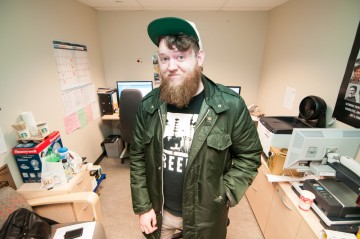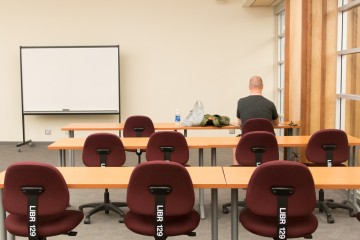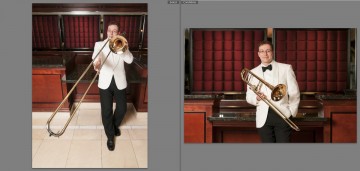Every modern photographer has used a zoom lens on a camera before. They help “crop in camera” so there’s nothing extraneous in the frame. While the different focal lengths afforded by zoom lenses (or a series of primes) can alter your field of view like a crop tool, they can also alter your perspective.
In film, one tool in a cinematographer’s arsenal is the “dolly zoom”, often used when protagonists have sudden realizations. The camera operator physically wheels the movie camera back while the focus operator zooms the lens in. The end result looks like the background is rushing towards the character. In still photography, the results are not as dramatic, but they are noticeable, and can be used to great effect.
In this wide-angle shot, my subject is standing in a room, but the story was specifically about how small the room was. To emphasize this size, I used my wide-angle lens and got very close to my subject. This made him look bigger and made the room look even smaller than it actually was.
Although wide-angle distortion can be fun to play with, it is not the most flattering of lenses. If you walk too close to a person with a lens like this, noses can be made comically large. People at the edges of the frame will look like they’re stretched out sideways. If you do want to photograph people with wide lenses, go ahead, but try and keep your human subjects in the middle if you want the chance to photograph them again. The rule of thirds doesn’t usually apply here.
Standard lenses, with a field of view similar to your own eyesight, are the lenses that you have not because they’re exciting, but because they are just useful for “everything else.” They are perfect for environmental portraiture, snaps around the house or group portraits. These lenses aren’t exciting, but they depict the world as you see it, and they will see the most use of any lens you own. Viewing the world through the funhouse mirror of a wide-angle can be fun at times, but the effect can grow tiresome if overused.
Telephoto lenses are most often used for sports and wildlife, as they provide the necessary reach, but these lenses are also very effective portrait lenses. While wide-angle lenses can emphasize noses, telephoto lenses can de-emphasize them and appear to flatten any protrusions, like the trombone slide below. Backing up and zooming in can be a simple way to just make people look better.
These techniques aren’t just for those with big cameras and a bag of lenses. The same principles apply to point-and-shooters as well. Just a few years ago, compact cameras were limited to standard zooms with 3x zoom. Now, manufacturers are packing 10x or 20x zoom lenses in even entry-level models, and that allows photographers of all kinds to have fun with focal lengths. It’s easy to try, and your subjects may thank you.











